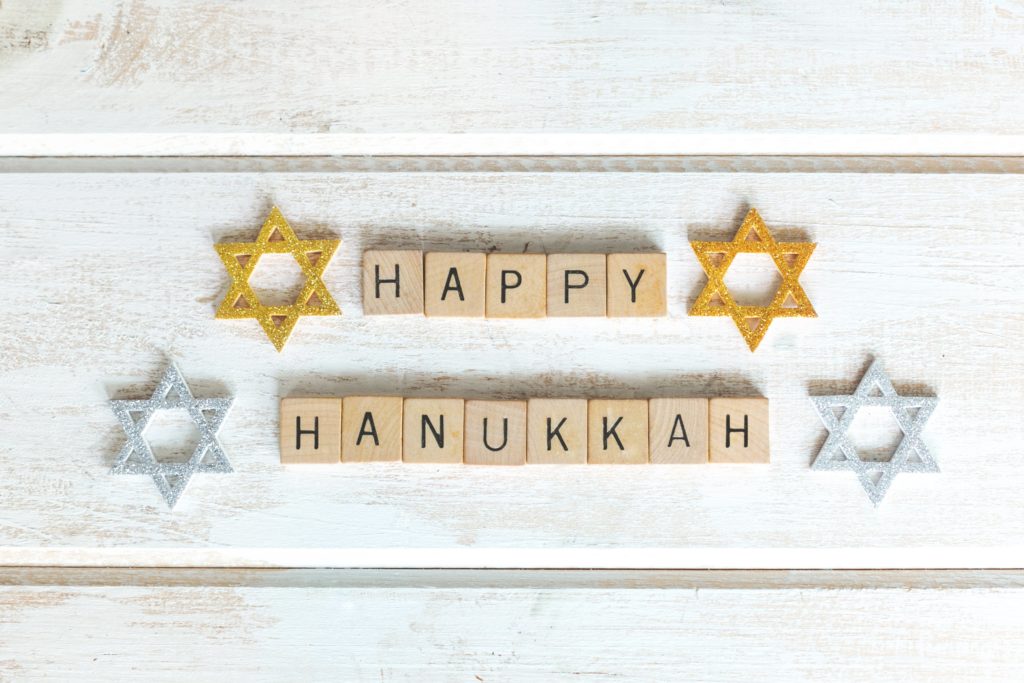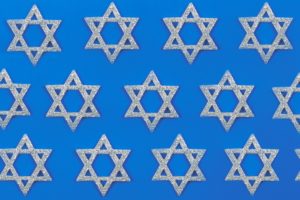October (Tishrei)
Rosh Hashanah means Head of the Year (Jewish New Year) – the brain of the year’s body, a holiday decreed important enough for two days – 48 hours of moments where our words and actions adjust the program for another year (Judgment). People wish each other “Shana Tova” during Rosh Hashanah.
The first day is moreso to think about “Are we living to our potential?”. The second day is more selfless, to think about “How are we contributing to the world?”. Over the period of ten days until Yom Kippur, the code can still be revised, by revising our own hearts and lives. After that, it is burned in; rewrites are awkward.
Customs include dipping apple in honey – it’s not referring to Apple in Garden of Eden (which actually was mistranslated and theories for it include fig, grapes, pomegranate, or wheat), it refers to Jewish people being compared to apples (the fruit grows before its leaves) – meaning we may not understand why we’re here at first, and the honey signifies that the experience will still be a sweet one even if it doesn’t make sense. The apple is similar to when we were given Torah – we said “we will do and we will listen”, meaning we will follow the Torah first even if we don’t understand and then we will listen more and let it resonate so we may eventually understand and get it right. Rosh Hashanah is also about sacrifice – like the story of the Binding of Isaac (Abraham being told to kill his son). It is not about the act of killing, but it’s about being willing to sacrifice what feels important to you – i.e. a young boy willing to give up his life for his sister.
Tishrei 1-2: It is customary on Rosh Hashanah to eat foods symbolizing sweetness, blessings, and abundance. We hear the sounding of the Shofar on both days of Rosh Hashanah during the daytime. On the first day of Rosh Hashanah, we visit a body of water or pond containing live fish and recite the Tashlich prayers. Amongst North African Jews, it is also customary to have a head of the fish to symbolize being at the head of the year (new year) instead of the back.
Tishrei 10: Yom Kippur ‘Day of Atonement’ is the holiest day in the Jewish Year. So holy that the soul is “at one” with G-d. When the soul is at one, all is forgiven. There’s a catch: Nothing must interfere with that oneness. Prohibition of work, eating and drinking, anointing with perfumes or lotions, marital relations, washing (for pleasure) and wearing leather shoes.
As Rosh Hashanah is about judgment, Yom Kippur is the 10th day after Rosh Hashanah, of which those 10 days are about repentance in order to make space for change. This is the final day of judgment and of remembrance. It is good to maintain moderation – we usually run by scripts (routine) and too much structure is not good but too much change is not good either (not healthily sustainable). Teiglach – a confection of dough balls dipped in honey/syrup and eaten at Rosh Hashanah.
Tishrei 15-21: Sukkot – The Sukkah (tabernacle) is a temporary hut with a roof of leaves, branches or sticks, reminding us of G-d’s ‘Clouds of Glory’ which sheltered the Jewish People during their 40 years wandering the Sinai Desert. Sukkot is a joyous holiday. For seven days, we are once again the original People of Moses wandering in the wilderness, surrounded by the Clouds of Glory. Only now those clouds are the greenery of a festive hut-called a Sukkah. All meals are eaten in the Sukkah, barring inclement weather. Food – Casserole food (stuffed vegetables) are traditionally eaten at Sukkot from Ancient Israel and Middle East – stuffed vegetables are still a bounty from the summer during this Fall holiday.
Tishrei 22-23: Simchat Torah – The joy of Sukkot expands for seven days and then bursts into Shemini Atzeret – a day containing all the joy of the coming year. The second evening of Shemini Atzeret, we celebrate Simchat Torah: All the Scrolls of the Torah are carried from their ark around the bimah seven times, with dance and song. In some communities, this is done on the first night as well. On the morning of the second day, every man and boy is called to the Torah, as we complete the yearly cycle of Torah reading, and begin immediately anew.
The awe and introspective contemplation of Rosh Hashanah and Yom Kippur induce a state of spiritual awakening that allows one to truly enjoy and be happy on Sukkot, the festival called “zman simcha’sainu – the time of our joy.” We are accustomed to think that joy is a spontaneous emotion, requiring no previous training, planning, or accomplishment. In reality, without serious preparation, sacrifices of time and wealth and effort (even deprivation and fasting) – i.e. Rosh Hashanah and Yom Kippur, “joy” i.e. Sukkot, in Jewish terms is not a lasting influence on us, authentic, and ultimately not even meaningful; it becomes “a good time,” “a night out,” something which temporarily gives us distraction, but – like drinking seawater – never really satisfies us. So we must condition ourselves to the necessity of preparation and training if we want the experience of joy to influence us in an authentic way. A second lesson of Sukkot is that joy is not a singular, unique emotion that is achieved in a vacuum. The holiday of Sukkot has many mitzvahs connected to it – such as in the booth constructed by Jews to eat and sleep in during the week of the holiday itself.

November (Cheshvan)
December (Kislev)
Chanukah until Zot Chanukah (eighth day) – How to Celebrate – Kindle the Chanukah Menorah on each of the eight nights. Use olive oil or paraffin candles-large enough to burn until half an hour after nightfall. Use a Shamesh (service candle) to kindle the lights, and place it in its special place on the Menorah. All members of the family should be present at the kindling of the Chanukah lights, and are kindled in the front window or by a doorway. Chanukah observances include the inclusion of Hallel and Al Hanissim in the daily prayers, eating food fried in oil and dairy foods, playing with the “dreidel” and giving gifts of money (“Chanukah gelt” – foil wrapped chocolate coins) to children.
Food – Potato latkes (pancakes) have been made since the middle ages and became the Hanukah dish. Oil is the whole story of the holiday. Sufganiyot is the other traditional Hanukah dish – which is the earliest dessert found (doughnut).
January (Tevet)
February (Shevat)

March (Adar)
Adar is the Happy Month(s) (March or also including February on leap years) – Take a moment to focus on things you are happy about. The position you were given is not for youself, it is to do good. People who contributed and were focused on giving to each other were happier and feel more purpose (Shekalim – giving money), not the recipient, which is why we give on Purim.
Purim – Ancient Story: We celebrate Esther saving us from Haman (villain of Purim) who wanted to exterminate the Jews. Esther could have killed Yehudim and kept Benjamin, but Esther was determined to save everyone. It is a story of love and unity, that is, unity between Purim and Esther. It is an important holiday, just like Yom Kippur – which means from Purim (Purim will be the only holiday once we are all saved by God). Purim is the physical celebration, while Yom Kippur is the other side of the coin, the spiritual one.
How to Celebrate: Listen to the Megillah – To relive the miraculous events of Purim, we listen to the reading of the Megillah (the Scroll of Esther) on Saturday night, Mar 11, and again on Sunday, Mar. 12, during the daytime. When Haman’s name is mentioned, we twirl gragers (noise makers) and stamp our feet to ‘drown out’ his evil name. We also eat hamantaschen cookies, which means “ears” for the defeated enemies’ ears or rumored to also be three cornered in the shape of Haman’s hat.
Send Gifts of Food – On Purim we emphasize the importance of Jewish unity and friendship by sending gifts of food to friends. Send a gift of at least two kinds of ready-to-eat foods (for example, pastry, fruit, beverage) to at least one friend on Mar. 12, during the daytime (men to men and women to women). Sending these gifts should be done through a third party. Children, in addition to sending their own gifts of food, make enthusiastic messengers. Also, concern for the needy is a year-round responsibility for the Jew. On Purim particularly, it is a special mitzvah to remember the poor – we can ideally give directly to the needy or as substitute through pushkas (charity boxes).
Fast of Esther – To commemorate the day of prayer and fasting which the Jews held before their victory, we fast before Purim, on March 9.
Meaning: We wear costumes to be able to look past the masks to see what is hidden, similarly to how we drink alcohol to a high degree on Purim until our illusions disappear and we “see God everywhere.” The purpose of Purim is to celebrate who we are, to take away the outer layer of consciousness (our superficial personality “self”), and to enter our most pure deepest self.

April (Nissan)
Passover is a lesson that we can’t appreciate something without the opposite (information vs question, exile vs peace after & redemption). It is also a lesson on how to say thank you – but it is more for ourselves and less for God (saying thank you makes us feel more thankful). Pesach (Passover) literally means the mouth that talks – telling us about the exodus from Egypt – using the power of imagination to make it more real (same Matzah we ate leaving Egypt) – How Jews were made to suffer and after Passover redemption, you should feel the lows/highs of being a Jew, the transformative journey, feel the oneness of being part of the Jewish people. Submerge your personality to attach yourself to something bigger and become greater (like Sports fans “we won” even though we weren’t on the team, not direct participants – we weren’t actually there).
4 Casualties of Exiles (Cups of Wine) – took away our 1) Kiddush – spiritual, 2) majed – physical, 3) Haggidah – past, 4) Future redemption niestzah.
A great leap – called Passover because we took a leap from slavery to greatness (redemption). The Hillel sandwich signifies exile/redemption as one unit. The day after Seder, we begin to count 49 days to the holiday of shavuot (when we received the Torah), because freedom without direction and purpose can be more unfulfilling than slavery.
Passover traditions – What is Chometz? Chometz is any food or drink made from wheat, barley, rye, oats, spelt, or their derivatives, which is forbidden on Passover because it is leavened or fermented. If a food contains any of these ingredients and is not certified as “kosher-for-Passover”, it’s considered chometz. Cleaning for Passover – Take all the chometz – both food and utensils used throughout the year (and not koshered for Passover)-and store it all away in closets or rooms that you will lock or tape shut. You’ll sell this chometz temporarily to a non-Jew. Clean your entire house, purging it of all crumbs and small pieces of food.
Nissan 13 – Search for Chometz. Nissan 14 – Burning the Chometz – On the morning before Passover, we burn the chometz that was found during the search or that was left over from breakfast and not stored away with the chometz that will be sold to a non-Jew. We can eat chometz only until the time indicated on the calendar. After that time we may eat only foods which are kosher-for-Passover. However, we do not eat matzah until the Seder.
How to Sell the Chometz – Since we can’t own chometz on Passover, we need to sell – before the time indicated on the calendar-to a non-Jew all chometz that we will not consume or destroy before Passover. This is not a simple transaction, which is why we empower a competent Rabbi to do it for us.
Nissan 15-16 Seder Nights – The first two nights of Passover, we conduct a Seder-a festive yet solemn event. At a table royally set with our best crystal and silver and the finest of kosher wines, we re-enact the Exodus from Egypt in ancient times. We also pray for the forthcoming redemption speedily in our days. Second night of Pesach – We begin Sefirat Ha-omer, counting of the 49 days between Pesach and Shavuot. Nissan 22 Last day of Passover – The eighth day is traditionally associated with our fervent hope for the coming of Moshiach. On this, day, the Baal Shem Tov said one can feel the approach of the Moshiach.
Seder Plate / Hillel Sandwich – Charoset, Bitter Herbs, and Matzo. Food – Matzo is eaten with salads and dips, and Matzo Ball soup is eaten (with knaidel – the matzah balls). Slivovitz can be drank because it is made from plums, not grain. Chremslach, also chremzlekh, are small thick pancakes or fritters made of matza meal. Matzo Brei – A breakfast made with matzah fried with egg.
May (Iyar)
Iyar 18 – Lag B’omer – Two reasons this is celebrated as a holiday 1) Between Passover and Shavuot, one year in the early 2nd century, 24k disciplines of Rabbi Akiva (greatest Sage of Israel in the Mishnaic period), passed away because they were not respectful enough to each other. Therefore, this period is a time of semi-mourning (no weddings, etc.). They stopped dieing on this day. 2) An outstanding later disciple of Rabbi Akiva, Rabbi Shimon bar Yochai, Mishnaic Sage and author of the Zohar, principle work of Jewish mysticism (Kabbalah), passed away. Having fulfilled his mission in this world, he asked that the anniversary be celebrated as a happy day.
June (Sivan)
Sivan 6-7 – Shavuout – Shavuout is a major festival, celebrating an event so important, the world would be an entirely different place without it. On this day, 3,329 years ago, the entire Jewish nation stood at the foot of Mount Sinai and the transmission of Torah began from heaven to earth. Torah was the first mindset to recognize the worth of ordinary people who were not kings and bullies. To champion human rights, public education, environmental responsibility, freedom of information, medical ethics, feminism, social action – the whole concept of progress and hope for the future.
No other teaching has had a comparable impact on our way of thinking today. Much of what Torah teaches us remains radical even in modern terms. G-d created both the world and its instructions. In its most specific sense, Torah refers to the Five Books of Moses, written down over a period of 40 years by Moses while he and his people roamed the Sinai desert. In a more general sense, Torah can include all 24 books of the Bible, oral traditions and writings of all Torah Sages through the generations, and the esoteric tradition of the Kabbalah.
Shavuout Observances – On the first night, many communities host an all-night learnathon. The next morning, May 31, every man, woman, and child attends services to hear the giving of the Ten Commandments read from a Torah scroll. It is especially important for children to be there, since they served as our guarantors the first time the Torah was given. Before the main meal on the first day of Shavuot, the tradition is to eat a festive dairy meal (not hard cheese). Cheesecake is a big hit. Blintzes also. It is customary on Shavuout to decorate our synagogues and homes with flowers, fruits and greens.
Sivan 12 End of Shavuot “Fulfillment” Days – When the Holy Temple stood in Jerusalem, and all Jews would come there for the three annual “pilgrimmage festivals” (Passover, Shavuot, Sukkot), Sivan 12 was the last of the seven days allotted for the offerings brought in conjunction with the Shavuot pilgrimmage (unlike the festivals of Passover and Sukkot, which have seven biblically mandated days, Shavuot consists only of one day; hence the additional six days of tashlumin or “fulfillment”). Thus we do not recite the tachnun (confession penitential suplication), and the other prayers omitted on a festival or joyous commemoration, from the 1st of Sivan until and including the 12th, as all these days bear a connection with the festival of Shavuot.
July (Tammuz)
Tammuz 17 – One of the 5 public fast days. It begins the ‘Three Weeks’ – a period of national mourning for the destruction of the two Temples, during which we celebrate no weddings and schedule no festivities. Moses descended from Mt. Sinai, after G-d had taught him the entire Torah for 40 days. In his hands, he carried the two stone Tablets engraved with the Ten Commandments. But when he saw the Jewish People worshiping the Golden Calf, he smashed the Tablets down in disgust.
August (Av)
Av 9 – Tisha B’av – Saddest day in the Jewish calendar. Commemorated as a 25-hour fast from sunset of the previous evening. Anniversary of the Divine decree that the Jewish people remain in the desert for 40 years until that generation died out, after they cried over the 12 Spies’ false report of the Land of Israel. Anniversary of the destruction of the First Temple (by Babylonians under Nebuchadnezzar), and of the Second Temple (by Romans under Titus). Also anniversary for the Spanish Inquisition.
Av 15 – End of the 40-year decree upon the Jewish people to remain in the desert. Reconciliation of the tribe of Benjamin with the other tribes of Israel.
September (Elul)
Month of Divine Compassion. Reflect on our actions and attitudes of the previous year, and resolve to correct our shortcomings. You can repair all that went amiss from the entire year-with study, with charity and good deeds, with meditation and prayer. We blow the Shofar every day of this month (except Shabbat), as a wake-up call to prepare for the magnificent days to come.
YOU MIGHT ALSO LIKE
Authentic Jewish Recipes
Challah Bread (using Bread Machine) Source: https://www.youtube.com/watch?v=4YKXB2qtncQIngredients:3/4 cup of warm water2 beaten eggs for cookingEither – 1 tbsp butter or 1/6 cup oil (use oil

Torah
Why is the Torah important? The giving of the Torah to Man equates to granting the responsibility of Man to “represent God” – of admitting

High Holidays – Yom Tov
October (Tishrei) Rosh Hashanah means Head of the Year (Jewish New Year) – the brain of the year’s body, a holiday decreed important enough for two

Historical Timeline
Before Common Era (BCE) 3760 – According to Maimonides, the world was created, and in 3761 Adam and Eve, the first man and first woman,